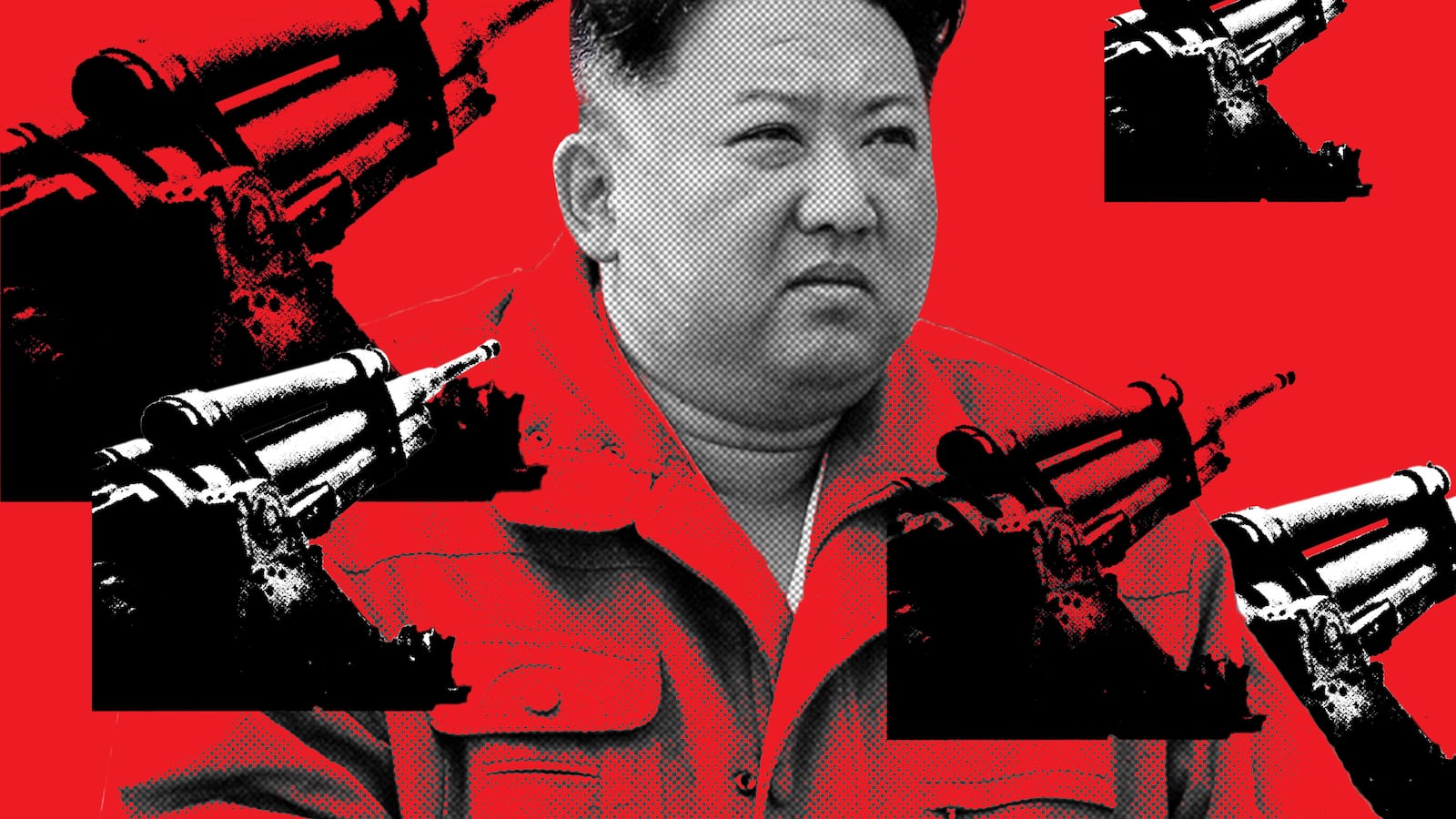The headlines blare out the fears that North Korea’s Kim Jong Un might fire a “tactical nuclear warhead” on targets in South Korea or maybe Japan. It’s not at all clear how much death and destruction a “tacnuke” would inflict. Like any other weapon, they come in different sizes and ranges, but any of them could probably wipe out a few thousand troops. Then there would be the fallout that would endanger the lives of thousands more people over a broad area, always at the mercy of wind currents.
Now, however, North Korean leader Kim Jong Un, proud though he is of his nukes, is showing off another much easier way to threaten the South. On Wednesday, he unleashed 250 cannon shots—seen as his primary weapon of choice rather than missiles and tactical nukes—into “maritime buffer zones” off the east and west coasts after South Korea launched more military exercises that the South’s conservative president, Yoon Suk-yeol, believes are essential for defense against the North.
Just to make sure South Korea got the message, Pyongyang’s Korean Central News Agency quoted a military spokesman saying, “Our Army strongly warns the enemy forces to immediately stop the highly irritating provocative act in the frontline areas.”
The latest North Korean artillery barrage comes on top of hundreds of cannon shots fired last week, signaling what Kim might seriously do if cornered, especially if personally endangered or simply angered by American and South Korean war games.
As North Korea’s cannonades make clear, Kim is believed to be far more likely to use artillery than tactical nukes in a showdown. North Korea has had more than 10,000 cannons above the Demilitarized Zone between the two Koreas ever since the Korean War, replacing old with new ones capable of firing shells 60 miles. The biggest U.S. base, Camp Humphreys, headquarters of U.S. forces in Korea, is just within range, as is nearby Osan Air Base, headquarters of the U.S. seventh air force. Kim is testing them for accuracy and distance just as he’s been test-firing dozens of missiles.
“Their long-range artillery can now attack areas far south of Seoul,” Bruce Bechtol, a former intelligence expert in the Pentagon and author of numerous books and articles on North Korea’s military posture, told The Daily Beast. “They can also completely inundate Seoul with the systems they have deployed along the DMZ at nearly a moment’s notice. That is the immediate tactical threat. It is also the most likely used in the early days of any conflict.”
David Maxwell, a former U.S. army special forces officer who served five tours in South Korea, told The Daily Beast he “thinks it is apples and oranges” when asked to compare the effectiveness of tacnukes versus artillery. “They create different effects,” he responded. “The artillery along the DMZ has resulted in the tyranny of proximity which has led to strategic paralysis by the alliance. The alliance will not respond kinetically anywhere deep into North Korea for fear of the response against Seoul.”

A TV screen shows a news program reporting North Korea’s missile launch displayed at the Yongsan Railway Station.
Kim Jae-Hwan/SOPA Images/LightRocket via GettyThe irony, Maxwell added, “is that the artillery, and specifically the threat to Seoul, has long been an effective deterrent, and the regime has never really needed nuclear weapons because they have been able to hold Seoul hostage without nuclear weapons.”
Bruce Bennett, Korea expert at the RAND Corporation, agreed. “If Kim wants to coerce the ROK (Republic of Korea), he can do so with regular or long-range artillery without having the escalatory impacts of using a nuclear weapon.”
Moreover, Bennett said, tacnukes would probably not suffice to “neutralize airfields” in South Korea or Japan. “An airfield with aircraft shelters will require a nuclear warhead able to cause a much bigger blast, likely in the hundreds of kilotons. Warheads that big will generally be interpreted by the U.S. as strategic nuclear weapons, requiring a much more serious U.S. response.”
Bennett believes Kim “will still use his conventional weapons for limited attacks” knowing “once he moves to his definition of tactical nuclear weapons, he would start a major war.”
More than four years ago, General Vincent Brooks, then U.S. commander in Korea, testified before a U.S. senate committee that long-range artillery posed “a serious, credible threat to 25 million citizens and approximately 150,000 U.S. citizens” in South Korea’s northern region. The inference was that artillery was the primary worry even though nukes and missiles were obviously “concerning.”
Like the Agent Orange the Americans spread over the jungles of Vietnam in a demented effort to destroy and expose the hideouts of the Viet Cong and “North” Vietnamese enemy during the Vietnam War, tactical nukes would not only inflict death right away but would leave generations in agony. Still, they would not be nearly as devastating as “strategic nuclear warheads” that could conceivably destroy San Francisco or Los Angeles.
Talk of a nuclear war is compelling, but the sense is North Korea is not too likely to deploy either strategic or tactical nukes, useful though the latter might seem against limited targets. Firing just one into the South would risk retribution far deadlier than the Korean War in which American warplanes bombed North Korean cities nearly to oblivion. Also, the Chinese wouldn’t want the North Koreans, whom they’re providing with oil and food and much else, to ignite a war when China is making a fortune off its highly favorable trade balance with the U.S. and its business with South Korea.
Artillery shells, however, are another matter. The danger of cross-border shelling right now is more acute than it’s been in nearly seven decades since the Korean War ended.

In this photo provided by the North Korean government, Kim Jong Un directs military personnel while inspecting military exercises at an undisclosed location in North Korea.
Korean Central News Agency/Korea News Service via APThink of the impact of firing a few of them into South Korea’s densely populated northern region, including the capital of Seoul, the west coast industrial port of Incheon, and other major population centers. Incheon’s Kangwha Island is right across a narrow waterway from North Korea, and Seoul is within reach of long-range artillery. A few “warnings shots' ' into South Korean territory would panic millions into leaping into cars, buses and trains, fleeing to safety well below the South’s northern tier.
North Korea has already fired nearly 1,000 shells close to the North-South line and sent warplanes into nearby skies in a show of what might really happen. Now, engaging in still more high-profile military exercises, South Korea and the U.S. are defying the North with their own shows of force in the face of Kim’s campaign of intimidation. Previous agreements with North Korea on flights and exercises close to the Demilitarized Zone are no longer valid. Meanwhile, war edges ever closer to reality.








